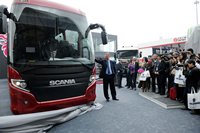
Scania has built a global reputation over a century and a quarter
SWEDEN Scania is celebrating 125 years of innovation in 2016. From its founding as a privately owned wagon-building company back in 1891 to today’s connected vehicles, Scania has stood steady through hostile take-over attempts and financial crises.
Here’s a brief rundown of Scania’s history, from its beginnings in 1891 through to today:
1891: The privately owned wagon-building company Vabis is established in Södertälje and sets about producing open goods wagons and transport wagons. Some 20 years later, Scania-Vabis is created through the amalgamation of Vabis with the Malmö-based, privately owned machine-manufacturing company Scania.
1923: Scania-Vabis designer August Nilsson develops a four-cylinder, overhead-valve engine. The engine’s power and reliability are of major benefit in trucks and buses.
1936: Scania-Vabis develops its first diesel engine, something that impresses the trade press during test drives. “To my surprise, I could hardly hear the engine,” wrote one journalist. “However, I certainly felt its effect as the bus shot forward like an arrow.”
1961: Scania-Vabis builds on its success in Brazil, opening its first ever production facility outside Sweden in São Bernardo do Campo, near São Paulo.
1969: Scania introduces a 350hp, 14-litre V8 turbocharged engine. It is the most powerful truck motor in Europe at the time and pioneers Scania’s low-rev philosophy with a high-torque output at low engine speeds.
1980: Scania launches the 2-series, the first modular commercial vehicle range
1988: The new 3-series is launched and the following year takes the International Truck of the Year award. Scania is now able to tailor trucks according to customer specifications.
1995: The 4-series is launched and the following year also receives the International Truck of the Year award.
2000: Scania’s millionth vehicle rolls off the assembly line.
2009: Scania launches the Scania Touring, a new coach built in partnership with Chinese bus bodybuilder Higer. Scania and Higer had joined forces to produce buses in China for the world market – a pioneering step forward in bus manufacturing.
2010: Boasting 730hp, Scania’s new V8 engine is the most powerful in the world without having to compromise on fuel efficiency.
2015: Scania delivers its 150,000th truck with activated connectivity.
Scania says it’s contributing to global sustainable transport, making it much larger than just its products. During 2016, the company’s most important asset – its employees – will also be in focus.


